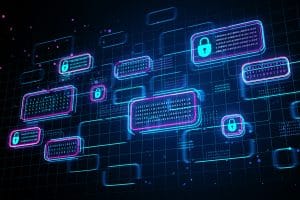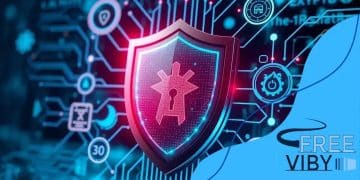The importance of cybersecurity in an increasingly digital world

Anúncios
In today’s hyper-connected society, the importance of cybersecurity cannot be overstated. From shopping online to accessing sensitive work files, every digital interaction presents potential risks.
As cyber threats grow more sophisticated, protecting your personal and organizational data has become not just a best practice, but a necessity.
Anúncios
Whether you’re a casual internet user or a corporate leader, understanding how to guard your digital footprint is crucial for staying safe in this fast-evolving landscape.
Understanding the Basics of Cybersecurity: What Everyone Should Know
Understanding the basics of cybersecurity is essential in a world where nearly every activity involves a digital component.
From checking your bank account to sending work emails, your information constantly travels through networks that can be targeted by malicious actors. Knowing how to protect that data is not just important, it is urgent.
Cybersecurity refers to the practices, technologies, and awareness strategies used to protect computers, mobile devices, networks, and data from unauthorized access or attacks. It is about prevention, detection, and response.
Anúncios
As digital threats grow more complex, individuals and organizations alike must develop a strong foundation in cybersecurity to stay secure.
According to recent studies, global cybercrime damage costs are expected to hit $10.5 trillion annually by 2025. This staggering number reflects the growing frequency and impact of cyberattacks across all sectors, making cybersecurity knowledge a critical life skill.
Common Cybersecurity Threats That Put You at Risk
Cyberattacks take many forms and can target anyone. Being aware of these threats is the first step in defending against them.
Malware
Malware is software intentionally designed to cause damage or steal information. It can include viruses, spyware, and trojans that silently infect your device and compromise your data.
Phishing
Phishing is a method used by attackers to trick users into revealing sensitive information. These scams often come in the form of emails or messages that appear to be from trusted sources, such as your bank or a government agency.
Ransomware
Ransomware locks or encrypts your files and demands payment in exchange for access. Some organizations have lost millions recovering from these attacks. The healthcare and education sectors have been frequent targets due to their reliance on sensitive data.
Password Attacks
These involve attempts to crack or steal login credentials. Using weak or repeated passwords across platforms increases vulnerability. In fact, compromised credentials are one of the top causes of data breaches globally.
Why Personal Data Protection Is the Foundation of Cybersecurity
Protecting personal data is at the heart of cybersecurity. When your personal information is exposed, it can be used for identity theft, financial fraud, and unauthorized account access. Taking basic precautions can dramatically reduce these risks.
Create Strong and Unique Passwords
Each account should have a different password that combines uppercase and lowercase letters, numbers, and special symbols. Avoid using names, birthdays, or common words.
Enable Two-Factor Authentication
Adding a second verification step when logging in increases your security significantly. Even if someone steals your password, they would still need a unique code sent to your device to gain access.
Limit the Information You Share Online
Be cautious with what you post on social media or share on websites. Cybercriminals often collect public information to tailor attacks that seem more credible.
Regularly Review Your Privacy Settings
Take the time to check the security settings of apps, email accounts, and social platforms to ensure you are not exposing more than necessary.
Smart Practices That Enhance Your Cybersecurity
Building secure digital habits doesn’t require advanced technical skills. It starts with small, consistent actions.
Keep Your Software Up to Date
Software updates often contain critical security patches. Delaying these updates can leave your devices exposed to known vulnerabilities.
Use Reliable Antivirus and Anti-Malware Programs
These tools serve as your digital immune system, scanning and eliminating threats before they cause harm.
Avoid Suspicious Emails and Links
Do not open emails from unknown senders or click on links that look unusual. Always verify the source before interacting with unexpected content.
Back Up Your Data Frequently
Store backups of important files in secure cloud services or external hard drives. This ensures that even if your device is compromised, your data remains safe.
Why Everyone Should Learn the Basics of Cybersecurity
Cybersecurity is no longer the sole responsibility of IT professionals. Every digital user plays a role in protecting information. According to recent research, more than 80 percent of data breaches involve some form of human error.
That means most incidents are preventable with the right knowledge and habits.
Understanding the fundamentals of cybersecurity empowers you to protect not only your own data but also the people and organizations you interact with.
It allows you to spot red flags, respond quickly to threats, and reduce the likelihood of becoming a victim of cybercrime.
Mastering the basics is the foundation of digital safety. It is the first and most important step toward creating a secure online environment for yourself and those around you.
Common Threats in the Digital Landscape and How They Impact Cybersecurity

As our dependence on technology increases, so does our exposure to digital risks. The modern digital landscape is filled with evolving threats that can disrupt personal lives and compromise entire organizations.
Understanding these dangers is a vital part of strengthening your overall cybersecurity posture.
According to recent reports, more than 80 percent of organizations worldwide have experienced at least one cyberattack in the last year.
These incidents not only result in financial losses but also damage trust and operational continuity. Recognizing the nature of these threats is the first step toward building strong defenses.
The Most Common Digital Threats You Should Know
Cyberattacks are no longer isolated incidents. They are strategic, targeted, and increasingly frequent. Below are the most widespread threats affecting users and organizations today.
Malware
Malware includes a wide range of harmful software such as viruses, trojans, and spyware. Once installed on a device, malware can steal sensitive information, corrupt files, or give attackers control over the system.
It often spreads through unsafe downloads, compromised websites, or infected USB drives.
Phishing
Phishing remains one of the most effective and common attack methods. It manipulates users into revealing confidential information by imitating legitimate sources like banks, companies, or government agencies.
Over 90 percent of successful cyberattacks begin with phishing emails.
Ransomware
Ransomware encrypts your data and demands payment for its release. In some cases, even after the ransom is paid, access is not restored. Healthcare, education, and public sector organizations have been prime targets because of the critical nature of their data.
Denial-of-Service (DoS) Attacks
These attacks flood a system with traffic, rendering services unavailable. DoS attacks can bring down websites, interrupt services, and cause significant business disruptions.
Why Social Engineering Is a Growing Threat in Cybersecurity
Not all attacks rely on technical methods. Some exploit human behavior.
Social Engineering Attacks
These attacks manipulate victims into performing actions or sharing confidential information. Instead of hacking into a system, the attacker deceives the user into giving them access voluntarily.
This can occur through impersonation, fake tech support calls, or phishing websites designed to look real.
Example
An employee may receive a call from someone claiming to be from the IT department asking them to reset their password or install a “security update.” Without proper training, the employee may unknowingly allow a breach.
These types of attacks highlight the need for cybersecurity awareness and regular training at all levels.
How to Identify and Respond to Phishing Attempts
Phishing is becoming increasingly sophisticated. Attackers often use urgency, fear, or curiosity to manipulate users into clicking links or downloading attachments. Here’s how to recognize a phishing attempt:
- Unfamiliar Senders or Domains
Emails from unexpected sources or with suspicious domain names should raise red flags. - Urgent Language or Threats
Messages claiming that your account will be locked or asking for immediate action are often fake. - Fake Login Pages
These mimic real websites to capture your username and password. Always check the URL before entering any credentials. - Unexpected Attachments
Files with unusual formats or unfamiliar names could contain malware.
The Importance of Staying Informed in a Changing Threat Environment
Cybercriminals are constantly developing new methods to exploit weaknesses. According to Accenture’s latest cybersecurity report, the average number of attacks per organization increased by over 30 percent in the past year.
This shift demonstrates how crucial it is for individuals and businesses to stay updated on emerging threats.
Regularly participating in cybersecurity training, following industry news, and reviewing organizational security protocols can make a meaningful difference in reducing your exposure to attacks.
Cybersecurity is not a static concept. It is an ongoing effort that adapts to the rapidly changing nature of digital threats. By understanding the risks present in the current landscape, you are better prepared to protect yourself and your data.
Best practices for securing personal data

In a time where so much of our daily lives unfolds online, protecting personal information is no longer optional. Data breaches, identity theft, and digital fraud have become alarmingly common, affecting individuals of all ages and backgrounds.
Adopting cybersecurity best practices is a powerful way to reduce your exposure and take control of your digital safety.
According to recent data, nearly 60 percent of consumers have experienced some form of data compromise in the past year.
These incidents can lead to severe consequences, including financial loss and emotional distress. By applying practical strategies, you can protect yourself and help prevent unauthorized access to your information.
Use Strong and Unique Passwords for Every Account
Passwords are the first line of defense for your personal data. Weak or reused passwords are one of the most common entry points for attackers.
What makes a strong password?
A secure password should be at least 12 characters long and include a mix of uppercase and lowercase letters, numbers, and special symbols. Avoid predictable combinations like “123456” or using personal details such as your name or birthdate.
Avoid reusing passwords across platforms
Using the same password for multiple accounts increases your risk. If one account is compromised, all others become vulnerable as well.
Consider using a password manager
Password managers help you create, store, and manage complex passwords securely, reducing the likelihood of forgetting credentials or relying on weak ones.
Enable Two-Factor Authentication to Add an Extra Layer of Security
Two-factor authentication (2FA) is a simple but highly effective measure that adds another barrier between your data and potential intruders.
- How 2FA works: In addition to entering your password, 2FA requires a second verification step, such as a code sent to your smartphone or generated by an authenticator app.
- Why it matters: Even if your password is stolen, 2FA can block unauthorized access by requiring that second layer of verification. This dramatically lowers the chances of your accounts being breached.
Be Thoughtful About the Information You Share Online
Sharing too much personal information online can expose you to serious risks. Cybercriminals often use publicly available details to launch targeted attacks.
Limit personal data on social media
Avoid posting sensitive details such as your address, phone number, or location in real-time. This information can be exploited for identity theft or phishing scams.
Think twice before completing online forms
Only share information on trusted, encrypted websites. Be selective and review privacy policies to understand how your data will be used.
Review your privacy settings frequently
Many apps and platforms default to public sharing. Adjust settings to limit visibility and control who can see your content and data.
Keep All Software and Devices Up to Date
Outdated software is one of the biggest vulnerabilities in personal cybersecurity. Cybercriminals often exploit flaws in older versions of operating systems and apps.
Why updates are important
Software updates contain security patches that fix known bugs and protect against newly discovered threats. Ignoring updates leaves you exposed to attacks that developers have already solved.
Set devices to update automatically
Whenever possible, enable automatic updates on your devices and applications to ensure you’re always using the most secure versions.
Secure Your Devices and Home Network
Protecting your devices is just as important as securing your accounts. The more layers of defense you have in place, the harder it becomes for attackers to succeed.
Install reputable antivirus and anti-malware software
These tools monitor and remove harmful programs before they can compromise your system. Choose software with real-time scanning and regular updates.
Use a firewall for network protection
A firewall helps block unauthorized access to your home network and serves as a barrier between your devices and external threats.
Avoid public Wi-Fi for sensitive transactions
Unsecured networks can be exploited to intercept your data. If you must connect, use a Virtual Private Network (VPN) to encrypt your traffic.
Why Cybersecurity Best Practices Matter More Than Ever
The growing volume and value of personal data make it a prime target for cybercriminals.
According to global cybersecurity insights, the average cost of a data breach has risen to over $4 million for organizations, and individuals are increasingly facing financial losses due to compromised personal accounts.
Adopting these best practices doesn’t just protect your information, it gives you greater control over your digital life.
Strong passwords, two-factor authentication, cautious data sharing, and regular updates collectively build a secure environment that minimizes risk.
Ultimately, securing your personal data is about responsibility and foresight. Each step you take strengthens your resilience and supports a culture of proactive cybersecurity in a world where privacy is constantly under threat
The Role of Organizations in Cybersecurity: Protecting Data, People, and Operations
In an era where cyberattacks are not a matter of if, but when, the role of organizations in cybersecurity is more important than ever.
From data breaches to ransomware, the digital threats faced by companies today are increasingly frequent, costly, and damaging.
Organizations are custodians of sensitive data. They hold customer information, employee records, financial assets, and intellectual property. Protecting these resources requires more than just reactive measures.
It demands a proactive, strategic approach that involves leadership, technology, and a culture of awareness.
According to recent reports, more than 60% of companies globally have experienced a cyberattack in the last 12 months.
Many of these attacks exploited preventable vulnerabilities, emphasizing the urgent need for every organization to build robust, modern cybersecurity frameworks.
Developing a Comprehensive Cybersecurity Strategy
A successful cybersecurity program begins with a clear, structured plan. This strategy should align with the company’s overall goals while adapting to evolving risks.
- Risk assessment is key
Organizations must regularly evaluate their infrastructure to identify vulnerabilities and prioritize which assets need the strongest protection. - Define security policies and access control
Establishing clear guidelines on data access, employee permissions, and system usage helps limit the scope of internal threats. - Integrate cybersecurity into decision-making
Cybersecurity should not be siloed in IT. It must be part of strategic business planning, especially when adopting new tools or digital platforms.
An effective strategy positions cybersecurity as a competitive advantage, not just a compliance checkbox.
Training Employees to Strengthen Human Defenses
Human error remains one of the top causes of cyber incidents. Educating staff at every level is essential to prevent costly mistakes.
Promote strong password habits
Encourage employees to use complex, unique passwords for each account, and consider implementing password managers across the organization.
Simulate phishing attacks
Test how employees respond to realistic phishing scenarios. This training reinforces awareness and improves reaction time.
Encourage early reporting of threats
Create a culture where employees feel safe reporting suspicious activity. Quick reporting can contain a breach before it spreads.
Continuous training programs ensure that your workforce becomes an active part of your cybersecurity defense—rather than a liability.
Investing in Smart Cybersecurity Technologies
While people are crucial, technology forms the backbone of an organization’s cybersecurity posture. Advanced tools can help monitor, prevent, and respond to threats in real time.
Firewalls and intrusion detection systems
These provide real-time analysis of incoming and outgoing traffic, helping identify unauthorized access or unusual behavior.
Encryption and data protection solutions
Encrypting sensitive data at rest and in transit prevents unauthorized users from reading information, even if they gain access.
Zero trust security models
A modern approach where no device, user, or system is trusted automatically. Every access request is verified, helping to contain breaches if they occur.
Cloud security tools
With remote work and cloud adoption rising, organizations must secure their cloud environments with visibility, control, and multi-factor authentication.
Strategic technology investment is a key differentiator between vulnerable companies and resilient ones.
Establishing a Cybersecurity Incident Response Plan
Being prepared for an attack is just as important as preventing one. Organizations must have a well-documented plan to act quickly and effectively when an incident occurs.
Define roles and responsibilities
Everyone on the response team should know their tasks—who communicates with stakeholders, who investigates, and who executes remediation steps.
Run incident simulations
Regularly simulate different types of cyber incidents to test your team’s readiness and refine your playbooks.
Plan for recovery and transparency
Quickly restoring systems is vital, but so is communicating with clients, partners, and regulators. Transparency helps maintain trust during crises.
A tested response plan minimizes operational disruption and protects brand reputation during emergencies.
Why Organizational Involvement in Cybersecurity Is Non-Negotiable
Every company, regardless of size or industry, is a target. Cybersecurity is not a technology issue, it is a business issue. The cost of ignoring it can be catastrophic, including legal penalties, revenue loss, customer churn, and reputational damage.
The most secure organizations today are those that invest in cybersecurity not just to prevent breaches, but to build digital trust. They train their people, secure their systems, monitor their environments, and prepare for the unexpected.
As cyber threats continue to evolve, so must your defenses. Leading organizations understand that cybersecurity is an ongoing effort, not a one-time solution. It’s a mindset that must be embedded into company culture and operations.
By taking a proactive, holistic approach, companies not only reduce risk, they gain a competitive edge in a world where digital trust is everything.
Future trends in cybersecurity technology

As digital threats grow more complex and aggressive, the future of cybersecurity depends on the ability to innovate. New technologies are reshaping how organizations detect, prevent, and respond to cyberattacks.
Staying informed about these advancements is essential not only for IT professionals but for any individual or business looking to secure their place in a digital-first world.
Reports show that over 80 percent of business leaders worldwide are increasing their cybersecurity investments in response to rising threats.
The adoption of cutting-edge solutions is no longer optional. It is a necessity for survival in the modern threat environment.
Artificial Intelligence and Machine Learning Are Redefining Threat Detection
Artificial intelligence (AI) and machine learning (ML) are among the most transformative forces in modern cybersecurity.
These technologies can process and analyze vast amounts of data at incredible speeds, identifying patterns and anomalies that may indicate a cyberattack.
How AI and ML improve cybersecurity
AI tools can automatically detect unusual activity on a network and trigger alerts before human analysts would recognize the threat. ML models continuously learn from past incidents, allowing systems to become smarter and more precise over time.
Where they are used
From spam filtering to behavioral analysis and automated threat response, AI and ML are becoming foundational in both personal and enterprise-level cybersecurity solutions.
As threats grow faster and more sophisticated, these technologies provide the agility needed to respond in real time.
Zero Trust Architecture Is Becoming the New Security Standard
The Zero Trust model is gaining traction as a leading cybersecurity strategy. It operates on a simple but powerful principle: never trust, always verify. In a Zero Trust environment, no user or device is trusted by default, even if they are inside the network.
Key elements of Zero Trust
Access is granted only after multiple layers of verification. User identities, device health, and behavioral context are all analyzed before access is approved.
Why this model is effective
Even if an attacker breaches the network perimeter, they cannot move freely without triggering alerts or requiring further authentication. This drastically limits the impact of internal threats or compromised credentials.
Zero Trust is especially valuable in a remote work environment where users connect from various locations and devices.
Cloud Security Is Evolving to Match a Remote-First World
With the rapid adoption of cloud computing, organizations must prioritize security measures that are purpose-built for cloud environments.
- Multi-cloud strategies
Many companies now operate across multiple cloud providers. This requires advanced tools to ensure visibility, consistency, and protection across platforms. - Cloud-native security solutions
Modern platforms offer integrated security controls such as encryption, identity access management, and automated compliance monitoring. - Why it matters
Cloud systems host sensitive data and business-critical applications. Failing to secure them exposes organizations to large-scale breaches and financial losses.
As cloud adoption continues to rise, future cybersecurity solutions will need to be flexible, scalable, and deeply embedded into every layer of infrastructure.
Blockchain Offers New Possibilities for Data Integrity
Blockchain technology is often associated with cryptocurrencies, but its applications in cybersecurity are expanding rapidly. It offers a decentralized and tamper-resistant method of recording information.
Securing digital transactions
Blockchain ensures that each transaction or data entry is recorded across multiple nodes, making unauthorized changes nearly impossible.
Use cases in cybersecurity
It is being explored for protecting supply chain data, verifying user identities, and securing healthcare records.
Long-term potential
By increasing transparency and reducing reliance on centralized servers, blockchain can enhance both trust and security in data management systems.
As organizations search for ways to protect data integrity and reduce vulnerabilities, blockchain may become a core component of future cybersecurity infrastructure.
Why Embracing Cybersecurity Innovation Is Crucial for the Future
Cyber threats are not only increasing in volume but also in sophistication. Traditional defense strategies are no longer sufficient to protect against the advanced tools used by attackers today.
Emerging technologies like AI, Zero Trust, cloud-native defenses, and blockchain represent the future of cybersecurity.
These solutions help businesses move from reactive to proactive strategies, allowing them to detect, adapt to, and neutralize threats faster than ever before.
Staying ahead of the curve requires more than simply purchasing the latest tools. It involves investing in a culture of security, updating systems regularly, and preparing teams to embrace change.
As the digital landscape continues to evolve, the organizations and individuals that adopt these future-focused cybersecurity trends will be the ones best positioned to thrive in the connected world.
Final Thoughts: Why Cybersecurity Demands Your Attention Today
The ever-expanding digital landscape brings incredible convenience, but it also introduces significant risks.
As cyberattacks grow more sophisticated and frequent, the importance of cybersecurity becomes a pressing concern for individuals, businesses, and governments alike.
A report from Southern New Hampshire University highlights that cybercrime is projected to cost the world $10.5 trillion annually by 2025, making it one of the greatest threats to global economic stability.
These crimes not only disrupt services and steal data, but they also erode trust in digital systems that power modern life.
Meanwhile, the Accenture Cybersecurity Index reveals that 68% of business leaders believe their cybersecurity risks are increasing, yet many organizations are still underprepared.
This disconnect shows a critical need for stronger investment in protection strategies, employee training, and cutting-edge technologies.
Whether you are managing a global enterprise or simply protecting your personal accounts, staying informed and proactive is essential. Adopting a cybersecurity-first mindset helps mitigate risks, reduces vulnerabilities, and builds digital resilience.
Ultimately, the choice to prioritize cybersecurity is not just a technical decision. It is a commitment to safeguarding privacy, securing data, and ensuring a safer digital future for everyone.
Now is the time to act, because the next threat could be just one click away.
FAQ – Frequently Asked Questions about Cybersecurity in the Digital Age
What is cybersecurity?
Cybersecurity refers to the practices and technologies designed to protect computers, networks, and data from attacks or damage.
Why is employee training important in cybersecurity?
Employee training is crucial because human error is a significant factor in many security breaches. Educated employees can better recognize and respond to threats.
What is the zero trust security model?
The zero trust security model means that no user or device is trusted by default, and every access request must be verified to ensure security.
How can I stay updated on cybersecurity threats?
You can stay updated by following reputable cybersecurity news sources, participating in training programs, and subscribing to threat intelligence services.
Liked the article?






